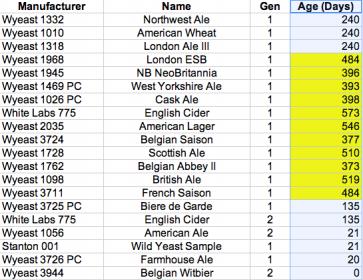I ran across this thread while researching how to make my yeast library. I am a newbie to homebrewing, but I have been growing microbes in the lab for a very long time and I couldn't resist commenting.
Brewitt has put together a nice recommendation for yeast storage and I thought I could comment on the science behind his findings.
1. Glycerol content.
Glyceral is a cryoprotectant but it is also toxic to the cells. The goal is to add the smallest amount of glycerol possible that will still prevent ice crystal formation, but not so much that it will kill the yeast cells. The industry standard is 15% volume/volume.
Someone mentioned trehalose in a prior post. Trehalose is a sugar that also serves as a cryoprotectant. It can be added to the freezing liquid or the yeast will produce plenty of it themselves if they are healthy. The best way to have plenty of trehalose is to well aerate your culture and make sure they are healthy when you freeze.
2. Slow cooling.
Best viability is obtained by cooling the culture in 15% glycerol for 1 degree per minute until you reach the desired storage temp. The ability of a homebrewer to do controlled rate freezing is not easy but can be obtained by using a
Mr. Frosty container that someone linked to earlier or by freezing in a propanol bath (which is basically what Mr. Frosty is). A propanol bath can be made by putting your yeast tubes in a ziplock bag, squeeze out the air and then put your bag into a larger jar containing propanol. Put your jar into the freezer for 24 hours. After 24 hours you can move your tubes to a more permanent storage container. Warning - isopropanol will wash-off permanent marker so use an ethanol-proof marker to label your vials or make sure your ziplock bag is sealed tight.
3. Fast thawing.
Fast thawing is the way to go. Like I said before, glycerol is toxic so when they wake up, you want them out of that glycerol solution as fast as possible. A few minutes in warm water and then into the wort. I think the slow thaw in the fridge and higher glycerol concentrations that people use may be the reason why they are having to store such large volumes to get decent yeast numbers. If I fast thaw, I can pitch at a 200x fold rate and get great numbers of yeast in 24 hours.
4. Storage volume.
I know you guys really want to make a "pitchable" product, but your best bet is going to be freezing in small volumes and pitching a starter. The extra step is the price you pay for being able to store your yeast in the freezer in large quantities for longe periods of time.
The Pros of a small frozen volume is:
- space - you can store many more tubes of a smaller volume. I can store 100 x 1ml tubes in the same space you can put 2 x 50ml tubes.
- washing - pitching the starter allows you to dilute the glycerol and wash it away by the time you pitch your homebrew. Glycerol tastes like soap and I am sure it's not a flavor you want to add to your beer. Also - like I said before . . . it is toxic to the cells so the more you can get out of the culture before you add to your fermenter, the healthier your brew will be.
- viability is less important - because you are pitching a starter, you don't have to worry about yeast counts and post-thaw viability. You only need a little to live to get the starter going and grow until you get the right amount of yeast. I know everyone struggles to quantify how much yeast you have, but you can go by optical density. You can literally tell how much yeast you have by how opaque it is. Once you get used to culturing yeast, you can tell just by glancing at it.
5. Storage temp.
Yeast is viable in a non-defrosting freezer at -20C for about 9 months to a year, at -80C for many years and in liquid nitrogen forever. This is because the yeast are still slightly metabolically active at -20C and the cryoprotectant you use to prevent ice crystals will slowly kill the yeast over time. They are less metabolically active at -80C and completely inactive in liquid nitrogen.
6. Testing viability.
Because most homebrewers are going to be using a -20C (standard freezer temp) then to get a good measure of your freezing technique, you should test your yeast viability within a couple of days of freezing it. If you wait longer, you are actually testing your freezing technique AND your freezer's ability to maintain a stable low temp and it is impossible to separate the 2 factors.
All that being said, I am about to start making my own yeast libraries and have access to all my lab equipment of you guys would like to put some real numbers to the protocol parameters. I know this is what Brewitt proposed, but it sounds like he has been swamped at work. What do you think? Tell me what you want to test and I will generate the data.






